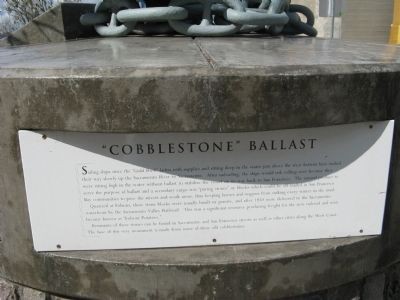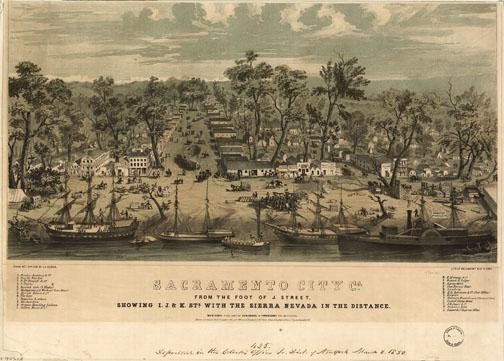Cobblestone Ballast Historical Marker
Introduction
Text-to-speech Audio
This historical marker commemorates the historic use of cobblestones as ballast in the 19th-century ships that sailed along the West Coast. Since the 1848 Gold Rush, ships transported supplies up the Sacramento River to unload their cargo on the docks of the Sacramento waterfront. After unloading their supplies, the wooden ships were at risk of toppling over, as they had tall masts and sat high in the water because of their buoyancy. To make the ships more stable, cobblestones were placed in the bottom of the ships as ballast, to keep them steady on the return journey. This historical marker was erected in 1998 by the Members of the Sacramento Valley Chapter of the American Merchant Marine Veterans (AMMV), along with their friends and families.
Images
Cobblestone Ballast Historical Marker

The Old Sacramento Waterfront, circa 1850s

Backstory and Context
Text-to-speech Audio
This historical marker, which was erected along the Sacramento River Waterfront near the Tower Bridge, commemorates the historic use of cobblestones as ballast. Because wooden sailing ships were so buoyant, with tall masts that also made them top-heavy, they were susceptible to capsizing once their hulls were empty after unloading all of their heavy cargo. To counteract this, ballast was placed in each ship's hold to keep the vessel steady, even after the cargo had been unloaded. Ballast sometimes took the form of rubble, millstones, or other weighty objects.
In the 19th century, the ships that sailed slowly up the Sacramento River frequently relied on cobblestones as a form of ballast. The cobblestones had another function, as they could also be used for paving city streets, and were therefore considered a secondary type of cargo. True cobblestones were rounded river rocks that had been naturally shaped by the river's current. Over time, though, it became more common to use Belgian Blocks. These stone blocks were quarried into a rough rectangular shape, and they retained some of the markings from the tools used during the quarrying process.
Many such stone blocks were quarried at Folsom, typically from either granite or basalt. Beginning in the mid-1850s, they were then sent via rail transportation on the Sacramento Valley Railroad and delivered directly to the Sacramento waterfront. As railroad freight, the blocks became known as "Folsom Potatoes." After serving as ship ballast, they were used to line the streets in San Francisco and Sacramento, as well as other cities and towns in Northern California and along the West Coast. In most places, these streets have long since been paved over with asphalt, but the previous layer remains underneath.
Sources
Castaneda, Christopher James. Simpson, Lee M.A.. River City and Valley Life: An Environmental History of the Sacramento Region. Pittsburgh, PA. University of Pittsburgh Press, 2013.
Isenberg, Andrew C.. Mining California: An Ecological History. New York, NY. Hill & Wang, 2005.
"The History of Cobblestone in the United States", Gavin Historical Bricks. July 24th, 2017. Accessed June 28th, 2023. https://www.historicalbricks.com/history-cobblestone-united-states/.
Whittle, Syd. "Cobblestone Ballast Historical Marker", Historical Marker Database. February 25th, 2009. Accessed June 27th, 2023. https://www.hmdb.org/m.asp?m=16474.
Syd Whittle, Historical Marker Database
City of Sacramento
